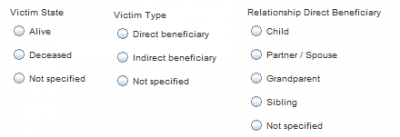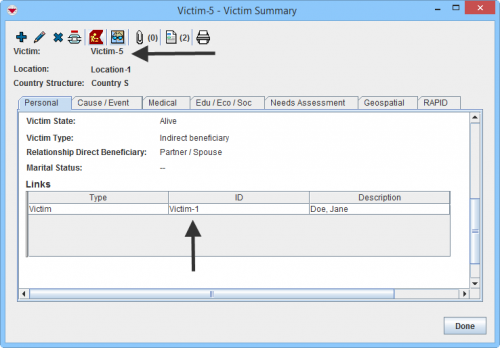Victim Summary Window
There are several types of classification of Victims:
- type of Accident the Victim is linked to
- Victim statistic category (APMBT, CCM, CCW, MOTAPM)
- Vulnerable group (Female headed household, HIV positive, Minority group, Orphan)
- Victim state (Alive, Deceased)
- Victim type (Direct beneficiary, Indirect beneficiary)
- Displacement status (Not Displaced, IDP, Refugee, Returnee)
- Current rehabilitation pillar (Emergency, Immediate, Transition, Stabilisation, Protection)
| |
The Victim item is the item which has had the most updates in version 6.0 which include 2 new subobjects and 124 fields. There are also fields that have been renamed in version 6.0. In version 6.0 fields that facilitate for countries to report to RAPID have been added to Accident and Victim. |
Cause, Needs assessment and Assistance relationships
The relationship between Cause and Needs assessment is not given i.e. just because a victim has a Cause (to be a victim), it does not mean that he/she has a Need, because Needs are related to the victims’s social conditions and work situation. A victim may have a Need even if he/she does not have a Cause recorded.
The relationship between Need and Assistance is not given i.e. just because Assistance is given in order to meet a Need it does not mean that the Need is fulfilled. A victim may receive assistance even if he/she does not have a recorded Cause and/or Need.
Cause subobject
| |
The Cause subobject enables to widen the victim definition |
Causes may be classified in the following categories:
- Medical (from injuries to epidemic)
- Mental and emotional (illness, dysfunction and/or stress)
- IDP/Refugee/Returnee (displacement/movement of people)
- Natural disasters (need of assistance caused by the effects of natural hazards)
- Protection (violence generates the need of assistance)
There are two ways of classifying injuries and amputations:
- using the "old" field Injury
- the new Cause subobject.
This page shows how the Injury field correspond to the new Cause classification.
Needs assessment subobject
Needs may be classified in the following categories:
- Emergency (health care and humanitarian aid)
- Stabilisation (health services, education, economic reintegration and physical accessibility)
- Transition (social inclusion, advocacy, data collection and physical accessibility)
- Protection (risk analysis)
- Legal support (law/policy)
- Institutional reinforcement (institution staff support, education/awareness and access to services)
Links between Victims
Victim Type and Relationship Direct Beneficiary are used for clarifying the type of relation between victims.
New fields in version 6.0
Since 124 new fields has been added in version 6.0 the list would be too long to present on this page and therefore there are links to the DataDictionary.
| New fields in version 6.0 | |
| Category | Number of fields |
| Advocacy Information | 2 |
| Demining Victim Information | 11 |
| Economic Information | 10 |
| Education / Professional information | 12 |
| Event Information | 5 |
| Household Information | 5 |
| Household Situation | 24 |
| Interview Information | 9 |
| Medical Information | 6 |
| Needs Assessment Information | 12 |
| Personal Information | 16 |
| Social Inclusion Information | 8 |
| Uncategorised | 1 |
The parts of the Summary window are explained Here.
| |
The format for showing Time to First Medical Facility and Time to Hospital has changed. Templates that contains these fields must be updated (see). Two new fields; Time Range to First Medical Facility and Time Range to Hospital are new fields in version 6.0 which are alternatives. |
External links
Read more about Victim assistance in:
- Anti-Personnel Mine Ban Convention
- Convention on Cluster Munitions
- Convention on the Rights of Persons with Disabilities



